Thursday, 21 November 2024
A must-read guide to the Three Sisters Walk
by Rose White
No trip to the Blue Mountains is complete without taking in the jaw-dropping vistas along the Three Sisters Walk.
Rising from the valley floor of the World Heritage Listed Blue Mountains National Park, the Three Sisters are breathtaking, ancient and folded deeply into the lore of the local Gundungurra and Darung People.
The best way to admire the sandstone maidens is by following the approachable Three Sisters Walk, which is helpfully dispersed with lookouts offering different vantage points. While the short, bush-hemmed trail is open to everyone, read on for a few things to know before you go.
What to expect of the Three Sisters Walk
Duration: 25–45 minutes
Distance: 0.8 kilometres return
Difficulty: Easy
Perhaps the best-known icon of the Blue Mountains, the Three Sisters spoils visitors with their monolithic sandstone splendour as they rise nearly one kilometre above sea level. Offering up the best vantage points to take in the sisters’ bush-enclosed beauty, this walk also lays out vistas across the soft-blue haze of the Jamison Valley and leads walkers under eucalypt canopies where bird songs melodically soundtrack the trail.
Admire the monolithic sandstone splendour of the Three Sisters. (Image: Destination NSW)
Keep an eye out for the superb lyrebird and vibrant rosellas, as well as spotted tail quolls and the Blue Mountains water skink. Along the way, take your time to absorb the views from Oreades Lookout, Lady Game Lookout and, if you’re eager, take a detour to Spooners Lookout. Pets are not allowed and smoking is prohibited.
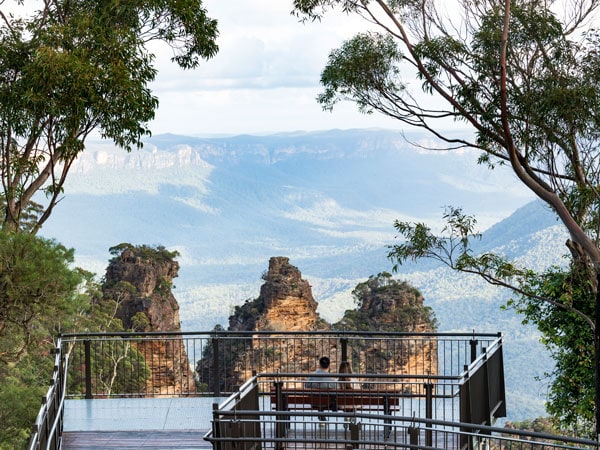
Absorb the views from Echo Point Lookout. (Image: Time Out)
How accessible is the Three Sisters Walk?
This is a family-friendly walk and fairly achievable for smallish children or those that can be carried. For those with limited mobility, seating and rest spots are dispersed frequently along the track.
Prams and wheelchair access with assistance is easy from Echo Point to Oreades Lookout with smooth terrain and no significant slopes. However, beyond this point it’s not recommended as there are some stairs. There is no wheelchair access from Lady Game Lookout to Honeymoon Bridge.
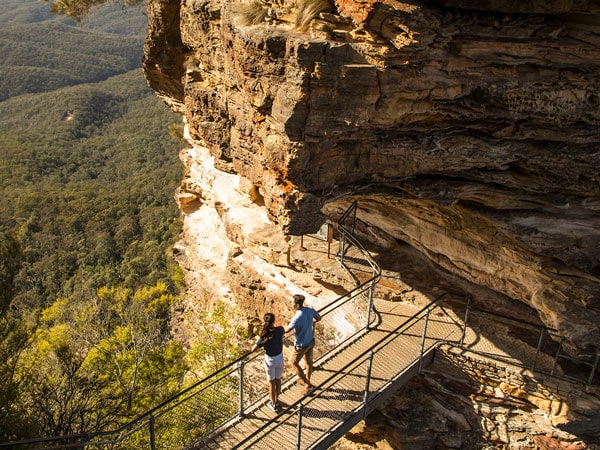
Honeymoon Bridge is a scenic spot to stop along the trail. (Image: Destination NSW)
Highlights of the Three Sisters Walk
Dramatic valley views and serene bushland make it a popular entry-level trail. In fact, the Three Sisters Walk is often considered to be up there with the best of Blue Mountains hikes.
From here, you can embark on spin-off walks that are longer and some more challenging, such as the Prince Henry Cliff Walk, Dardanelles Pass Loop Track and the Grand Cliff Top Walk. However, if you only have time for one, the Three Sisters Walk is a fantastic option.

Three Sisters is an iconic landmark in the Blue Mountains National Park. (Image: Destination NSW)
Echo Point
Starting at the Echo Point Visitor Centre, make your way to Echo Point Lookout, where you’ll be treated to panoramic views of the Three Sisters and Jamison Valley. Also, spot the Ruined Castle and Mt Solitary.
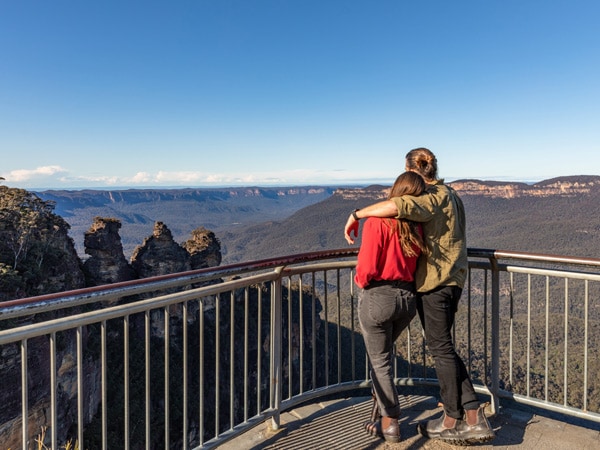
Take in panoramic views of the Three Sisters from Echo Point Lookout. (Image: Destination NSW)
Oreades and Lady Game lookouts
Sweeping views of the valley unfurl as you step out onto the viewing platform at Oreades Lookout. There’s plenty of room at this lookout to get your money shot and soak up those mountain vibes. Then its another 50 metres to reach Lady Game Lookout, where you find yourself at an even closer vantage point. Another stone archway to the side of the lookout leads onto the Giant Stairway.
Giant Stairway
Leading into the Jamison Valley by way of nearly 1000 steps, the Giant Stairway lives up to its name. If you’re not keen to tackle the full staircase, you need only take a handful of steep steps to reach the first of the Three Sisters via Honeymoon Bridge.
Honeymoon Bridge
This is the last part of the walk and, of course, optional for the vertigo prone. It connects walkers to an overhang on the First Sister, where you can look back to the Giant Stairway. There’s not much space on the other side, so take a quick snap and head back across.
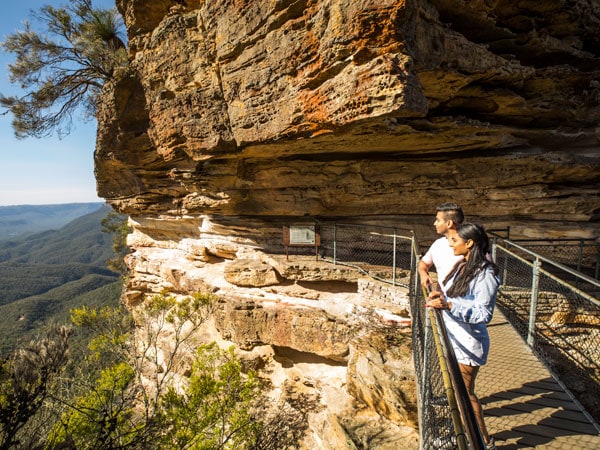
Honeymoon Bridge is the final section of the trail and the one that gets you closest to the sisters. (Image: Destination NSW)
Spooners Lookout
A short detour from your return journey will lead you to Spooners Lookout, from where you may marvel at the Three Sisters welded to the valley below. It’s just five minutes extra, but worth the extra steps. The lookout is also accessed from Echo Point Visitor Centre and is wheelchair-friendly.
About the Three Sisters
Long a significant part of the landscape for the Gundungurra and Darung People, the Three Sisters continue to embody deep cultural importance for Traditional Custodians.
The Dreaming story of the Sisters does vary between groups, however, as told by Sharon Brown of the Burragurrang Clan of the Gundungurra Nation, the tale speaks of three beautiful sisters, Wimalah, Meeni and Gunedoo, who were in love with three brothers from the neighbouring nation of the Dharruk people.

The Three Sisters are of deep cultural importance to the traditional custodians of the region. (Image: Destination NSW)
Tribal law forbade their union, but this failed to deter the brothers, who fought to win the sisters by force. Eventually the skirmish led clever man (Kuradjuri) to turn the sisters to stone for their own safety, with the full intention of restoring them to flesh and blood once the fighting had ceased.
Unfortunately for the sisters and their would-be lovers, Kuradjuri died in the battle, and so they remain stone-bound and unmarried for eternity.
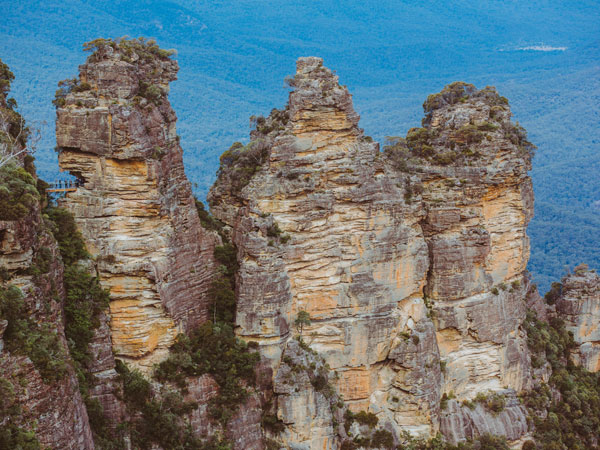
The Three Sisters rose from the northern escarpment of the Jamison Valley. (Image: Tourism Australia)
In a geological and perhaps less thrilling interpretation of events, the Three Sisters were formed from Hawkesbury sandstone by land erosion and volcanic activity around 200 million years ago.
Today, their rough-hewn and craggy beauty is shrouded in a touch of mystery and their engaging Dreamtime story continues to draw visitors from sunrise to sunset as they ponder whether the entrapped sisters will ever be free to love.
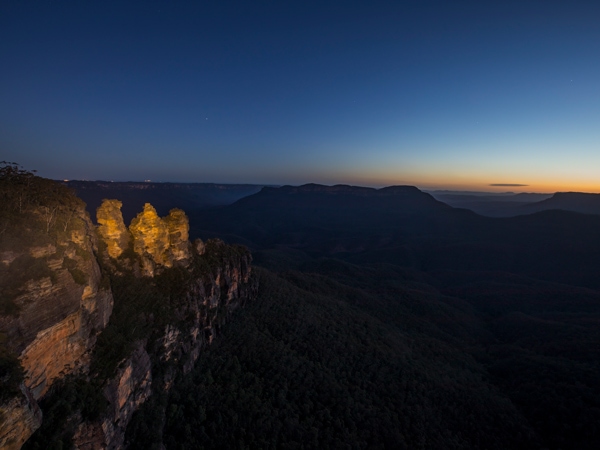
The sun rises over Three Sisters and the Jamison Valley. (Image: Destination NSW)
Safety information
As with all bushwalking, it’s important to be properly prepared. While the Three Sisters Walk is a short and relatively easy track, if you decide to add on another walk or tackle the Giant Stairway, be sure to pack enough water, wear sun protection and let someone know where you’re going.
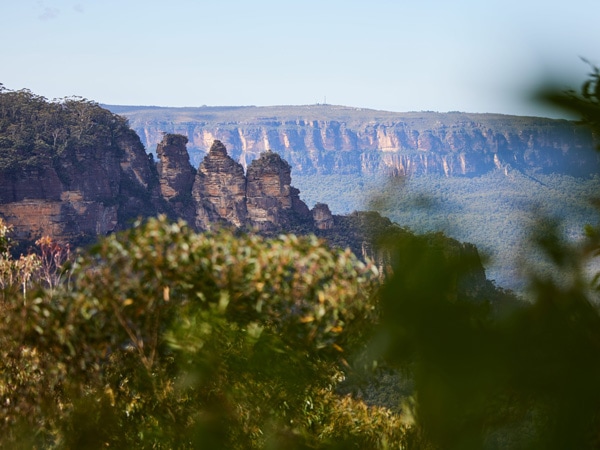
Capture the magnificent beauty of the iconic Three Sisters. (Image: Destination NSW)
Parts of the Three Sisters Walk are close to cliff edges. Use caution and common sense, especially during busy periods, and keep children close at all times. Also, you can check the National Parks website ahead of your trip to make sure there are no closures or bushfire alerts.
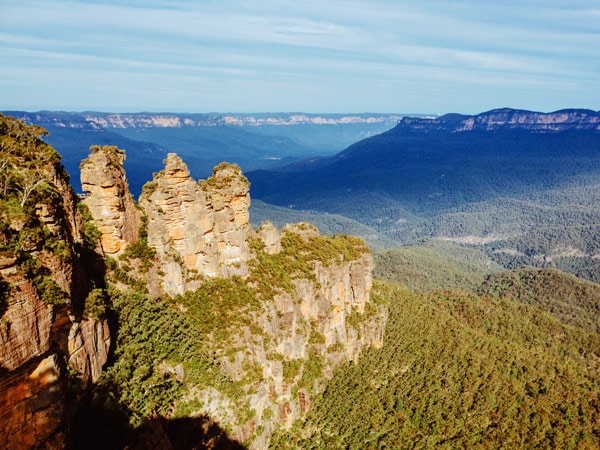
Be sure to prepare before you go to the Three Sisters Walk. (Image: Tourism Australia)
Getting there and parking
Just an hour and a half from Sydney, you can reach the Three Sisters Walk from Echo Point Visitor Centre in Katoomba.
Parking is available at the Echo Point car park and on nearby streets, and there are designated disabled spaces. The car park does fill up on weekends, so try to arrive early and allow plenty of time.
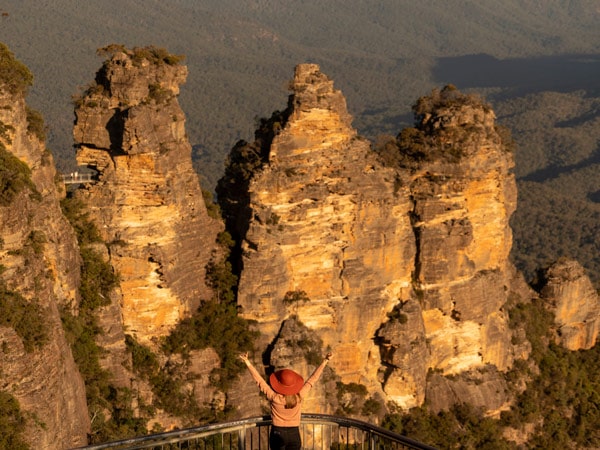
Strike a pose in front of the spectacular sandstone backdrop. (Image: Tourism Australia)
Things to do nearby
There’s plenty to do around Katoomba and around once you’ve completed the Three Sisters Walk, with plenty to add to your day’s itinerary. Pop across the valley to Scenic World, where you can ride the world’s steepest railway. Cool off at a local waterfall, or hit nearby Leura’s eclectic collection of boutiques and shops.
If you’re here on a weekend, you should also check to see if any of the local markets are running. Or head over to Mountain Culture Beer Co, one of the best watering holes in the Blue Mountains, for a delicious craft beer and fried pickles.
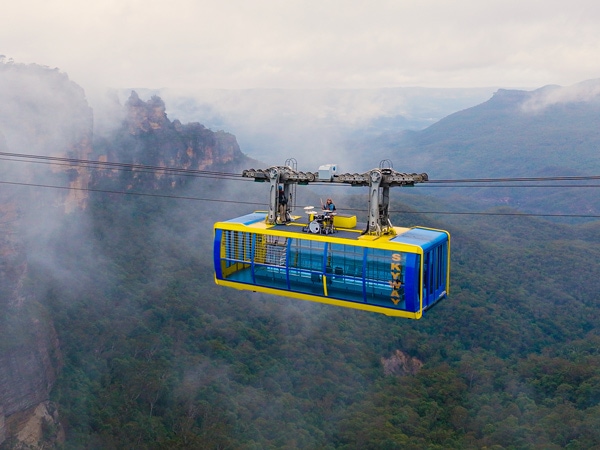
Soar above Jamison Valley on the Scenic World cable car. (Image: Destination NSW)
The post A must-read guide to the Three Sisters Walk appeared first on Australian Traveller.
